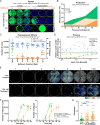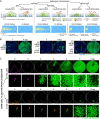The FDA-Approved Drug Nelfinavir Inhibits Lytic Cell-Free but Not Cell-Associated Nonlytic Transmission of Human Adenovirus
- PMID: 32601166
- PMCID: PMC7449217
- DOI: 10.1128/AAC.01002-20
The FDA-Approved Drug Nelfinavir Inhibits Lytic Cell-Free but Not Cell-Associated Nonlytic Transmission of Human Adenovirus
Abstract
Adenoviruses (AdVs) are prevalent and give rise to chronic and recurrent disease. Human AdV (HAdV) species B and C, such as HAdV-C2, -C5, and -B14, cause respiratory disease and constitute a health threat for immunocompromised individuals. HAdV-Cs are well known for lysing cells owing to the E3 CR1-β-encoded adenovirus death protein (ADP). We previously reported a high-throughput image-based screening framework and identified an inhibitor of HAdV-C2 multiround infection, nelfinavir mesylate. Nelfinavir is the active ingredient of Viracept, an FDA-approved inhibitor of human immunodeficiency virus (HIV) aspartyl protease that is used to treat AIDS. It is not effective against single-round HAdV infections. Here, we show that nelfinavir inhibits lytic cell-free transmission of HAdV, indicated by the suppression of comet-shaped infection foci in cell culture. Comet-shaped foci occur upon convection-based transmission of cell-free viral particles from an infected cell to neighboring uninfected cells. HAdV lacking ADP was insensitive to nelfinavir but gave rise to comet-shaped foci, indicating that ADP enhances but is not required for cell lysis. This was supported by the notion that HAdV-B14 and -B14p1 lacking ADP were highly sensitive to nelfinavir, although HAdV-A31, -B3, -B7, -B11, -B16, -B21, -D8, -D30, and -D37 were less sensitive. Conspicuously, nelfinavir uncovered slow-growing round HAdV-C2 foci, independent of neutralizing antibodies in the medium, indicative of nonlytic cell-to-cell transmission. Our study demonstrates the repurposing potential of nelfinavir with postexposure efficacy against different HAdVs and describes an alternative nonlytic cell-to-cell transmission mode of HAdV.
Keywords: adenovirus death protein; antiviral agents; cell lysis; compound screening; drug repurposing; fluorescence imaging; membrane rupture; oncolytic virus; plaque assay; virus transmission.
Copyright © 2020 Georgi et al.
Figures






Similar articles
-
Emerging antiviral therapeutics for human adenovirus infection: Recent developments and novel strategies.Antiviral Res. 2021 Apr;188:105034. doi: 10.1016/j.antiviral.2021.105034. Epub 2021 Feb 10. Antiviral Res. 2021. PMID: 33577808 Free PMC article. Review.
-
A high-content image-based drug screen of clinical compounds against cell transmission of adenovirus.Sci Data. 2020 Aug 12;7(1):265. doi: 10.1038/s41597-020-00604-0. Sci Data. 2020. PMID: 32788590 Free PMC article.
-
Evaluation of multiplex type-specific real-time PCR assays using the LightCycler and joint biological agent identification and diagnostic system platforms for detection and quantitation of adult human respiratory adenoviruses.J Clin Microbiol. 2010 Apr;48(4):1397-403. doi: 10.1128/JCM.01600-09. Epub 2010 Jan 6. J Clin Microbiol. 2010. PMID: 20053853 Free PMC article.
-
HAdV-C6 Is a More Relevant Challenge Virus than HAdV-C5 for Testing Antiviral Drugs with the Immunosuppressed Syrian Hamster Model.Viruses. 2017 Jun 13;9(6):147. doi: 10.3390/v9060147. Viruses. 2017. PMID: 28608847 Free PMC article.
-
The Adenovirus Death Protein - a small membrane protein controls cell lysis and disease.FEBS Lett. 2020 Jun;594(12):1861-1878. doi: 10.1002/1873-3468.13848. Epub 2020 Jun 19. FEBS Lett. 2020. PMID: 32472693 Review.
Cited by
-
Adenoviruses in medicine: innocuous pathogen, predator, or partner.Trends Mol Med. 2023 Jan;29(1):4-19. doi: 10.1016/j.molmed.2022.10.001. Epub 2022 Nov 4. Trends Mol Med. 2023. PMID: 36336610 Free PMC article. Review.
-
A versatile automated pipeline for quantifying virus infectivity by label-free light microscopy and artificial intelligence.Nat Commun. 2024 Jun 15;15(1):5112. doi: 10.1038/s41467-024-49444-1. Nat Commun. 2024. PMID: 38879641 Free PMC article.
-
Emerging antiviral therapeutics for human adenovirus infection: Recent developments and novel strategies.Antiviral Res. 2021 Apr;188:105034. doi: 10.1016/j.antiviral.2021.105034. Epub 2021 Feb 10. Antiviral Res. 2021. PMID: 33577808 Free PMC article. Review.
-
Microscopy deep learning predicts virus infections and reveals mechanics of lytic-infected cells.iScience. 2021 May 15;24(6):102543. doi: 10.1016/j.isci.2021.102543. eCollection 2021 Jun 25. iScience. 2021. PMID: 34151222 Free PMC article.
-
Current antiviral agents against human adenoviruses associated with respiratory infections.Front Pediatr. 2024 Aug 29;12:1456250. doi: 10.3389/fped.2024.1456250. eCollection 2024. Front Pediatr. 2024. PMID: 39268358 Free PMC article. Review.
References
Publication types
MeSH terms
Substances
LinkOut - more resources
Full Text Sources
Medical
Miscellaneous

